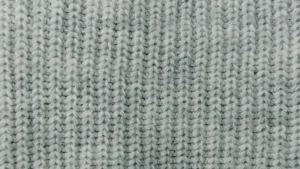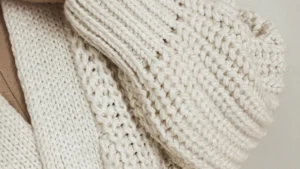
High quality jersey knit fabric is everywhere these days, from your favorite t-shirt to cozy home décor. You might wonder what makes this high quality jersey knit fabric so popular for DIY and sewing projects. Check out these quick facts:
Aspect | Details |
|---|---|
Market Size (2024) | |
Comfort | Soft, stretchy, breathable |
Top Uses | Apparel, home décor |
People love using high quality jersey knit fabric because it feels soft, stretches easily, and works for all sorts of DIY sewing projects. Available in a wide range of colors and prints, this high quality jersey knit fabric keeps every sewing project fresh. Whether you’re new to sewing or have years of experience, you can jump into a DIY project with high quality jersey knit fabric and see great results.
Key Takeaways
High quality jersey knit fabric feels soft and stretches easily. It lets air through, so it is great for comfy clothes and home projects.
You can use this fabric for many things. It works for t-shirts, dresses, leggings, pajamas, baby clothes, pillow covers, and curtains.
Jersey fabric is simple to sew if you have the right tools. Use a ballpoint needle and a zigzag stitch. These help the seams stay stretchy and look neat.
You can reuse old jersey clothes to make new things. This is fun and good for the planet. It also helps you get better at sewing.
Jersey knit fabric is used in medical and tech items too. It is good for bandages and compression wear. It stretches, lets skin breathe, and feels soft.
What Is Jersey Knit Fabric
Key Features
Jersey knit fabric stands out because of its soft feel and stretchy nature. You can spot jersey fabric by its smooth front and slightly rough back. This fabric uses a single needle to create a plain knit, which gives it a lightweight and flexible texture. If you compare jersey to other knits, you’ll notice some big differences:
Jersey Knit | Rib Knit | Interlock Knit | |
|---|---|---|---|
Knit Type | Single/Plain knit (single needle) | Double bed knitting (two needles) | Double bed knitting (two needles) |
Stitch Composition | Combination of knit and purl | Vertical ribs (1×1 or 2×2 knit/purl) | Double-faced rib (two layers) |
Fabric Sides | Distinct right and wrong side | Almost identical sides | Reversible, no right or wrong side |
Weight | Lightweight | Heavier than jersey | Heavier and thicker than jersey |
Stretchiness | Less stretchy unless blended | Very stretchy | Less stretchy than jersey |
Edge Behavior | Edges curl when pulled | Edges lie flat | Stable, does not curl |
Common Uses | T-shirts, dresses, tops | Cuffs, necklines, turtlenecks | Pants, skirts, tanks |
You’ll find jersey fabric in everything from T-shirts to flowy dresses. Cotton jersey is especially popular for its softness and breathability. When you want to sew knit fabric, you should use a ballpoint needle and a zigzag stitch. This helps keep the loops safe and stops snags or holes. If you’re learning how to sew knit fabric, start with simple patterns made for stretch materials.
Tip: Always wash your high quality jersey knit fabric in cold water and air dry it flat. This keeps the fabric stretchy and helps it last longer.
Benefits for Projects
Jersey knit fabric brings a lot of perks to your sewing projects. You get comfort, flexibility, and style all in one. Here’s why you’ll love using jersey fabric for both fashion and home:
Stretchability: Jersey fabric stretches both ways, so your clothes move with you. This is perfect for activewear, loungewear, and fitted garments.
Softness: High quality jersey knit fabric feels gentle on your skin, making it great for everyday wear and baby clothes.
Breathability: Cotton jersey lets air flow, keeping you cool in warm weather.
Durability: Jersey fabric holds up to lots of washing and wearing. It keeps its shape and resists wrinkles.
Draping: You’ll notice how jersey fabric drapes nicely, giving dresses and tops a flattering look.
Versatility: You can use jersey fabric for everything—T-shirts, underwear, pajamas, bed sheets, and even pillow covers.
If you want to know how to hem knit fabric, try using a stretch stitch or a twin needle. This keeps the hem stretchy and neat. When you sew knit fabric, always fold it instead of hanging it. This stops it from stretching out of shape.
Jersey fabric makes sewing fun and easy. Whether you’re making cotton jersey pajamas or learning how to sew knit fabric for the first time, you’ll find endless ways to use high quality jersey knit fabric in your projects.
T-Shirts
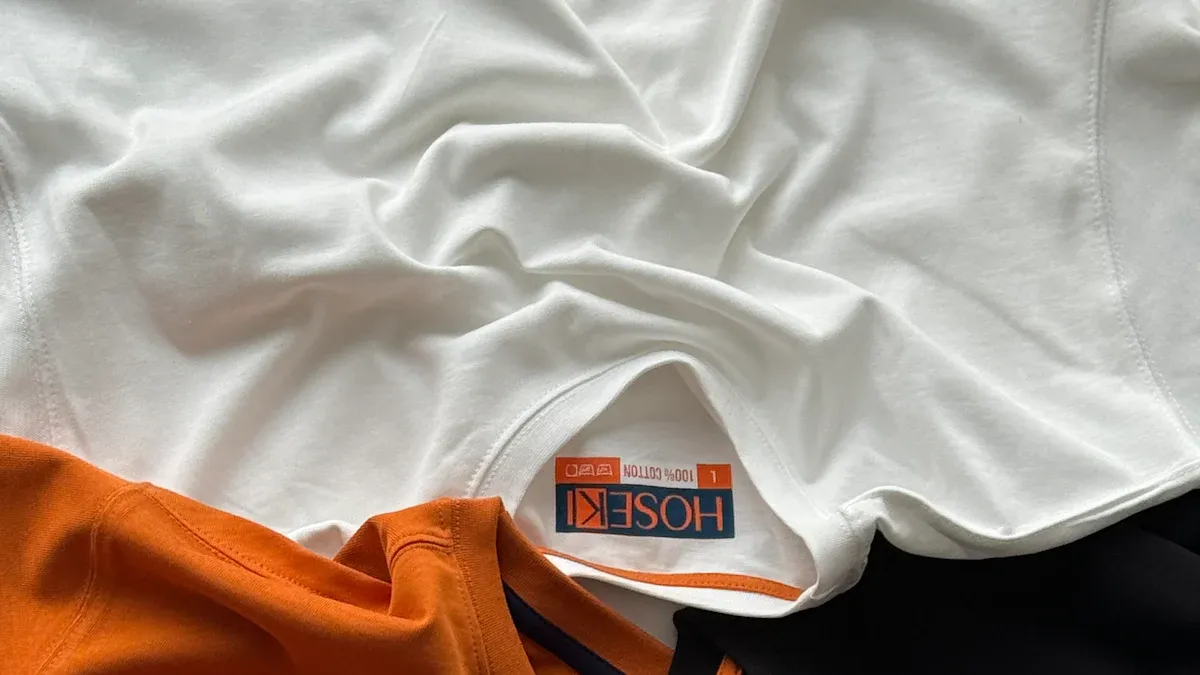
Classic Styles
Most people own a t-shirt made from jersey fabric. This fabric feels soft and stretches when you move. It is great for many sewing projects. Classic t-shirts are comfy and easy to wear because of jersey. Here are some popular t-shirts made with high quality jersey:
T-Shirt Style | Fabric Composition | Weight (oz) | Key Features & Design Elements | Customer Ratings & Reviews Highlights |
|---|---|---|---|---|
Gildan 5000 Heavy Cotton T-Shirt | Mostly 100% cotton; some colors 50/50 or 90/10 cotton/poly blends | 5.3 oz (US) | Classic fit, seamless double-needle collar, taped neck and shoulders, tear-away label | 97% 4-5 stars; praised for comfort, durability, wide color range, and bulk order suitability |
Gildan 64000 Softstyle T-Shirt | 100% ring-spun cotton or blends depending on color | 4.5 oz (US) | Semi-fitted, seamless collar, taped neck and shoulders, tear-away label, high stitch density | 97% 4-5 stars; noted for softness, comfort, vibrant colors, and excellent print surface |
Hanes 5280 Essential T Cotton T-Shirt | 100% ComfortSoft combed cotton or blends (varies by color) | 5.2 oz | Shoulder-to-shoulder taping, double-needle stitched collar, tear-away labels | 94% 4-5 stars; valued for fit, color quality, and suitability for bulk orders |
Gildan 8000 DryBlend T-Shirt | 50/50 cotton/polyester blend | N/A | Moisture-wicking, tapered neck and shoulders, seamless collar | Positive feedback on comfort and practical wearability |
Next Level Apparel 3600 Unisex T-Shirt | 100% combed ringspun cotton or 90/10 cotton/polyester (Heather) | 4.3 oz (US) | Lightweight, rib knit neck, side seams, tear-away label, tailored fit | 100% 4-5 stars; highly rated for softness, fit, durability, and suitability for screen printing and hot weather wear |
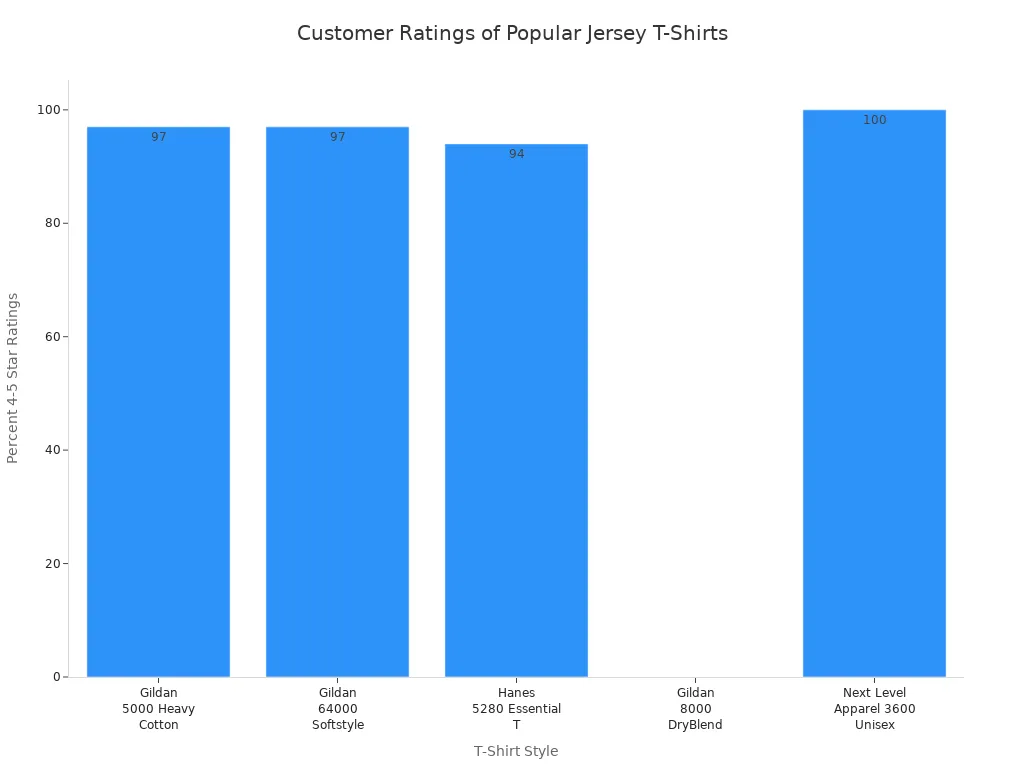
Jersey t-shirts get high scores for comfort and fit. People wear these shirts every day, for sports, or as layers. If you want to sew, t-shirts are a good first project. You can use simple patterns and learn how jersey fabric works.
Customization Tips
It is easy to make t-shirts unique with jersey fabric. You can add embroidery for small logos or collars. Screen printing and heat transfers also work well on jersey. These methods make bright and lasting designs. Eco-friendly jersey looks nice with embroidery and screen printing. Heat transfers stick best to recycled polyester jersey.
Tip: Keep your designs small. Big prints can stretch or crack on jersey fabric. Put logos on the chest or sleeve for best results.
You can change how your t-shirt fits too. Try making the neckline different or shape the sides. Use a ballpoint needle and zigzag stitch when sewing jersey. This helps the fabric stretch and keeps your sewing neat. If you want to try new patterns, start with basic shapes. Then add your own ideas. Jersey fabric lets you try new things and learn as you sew.
Dresses and Skirts
Everyday Dresses
Jersey fabric is great for making many kinds of dresses. It feels soft and stretches, so you feel comfy all day. Ribbed jersey is good if you want a dress that fits close to your body. Hacci jersey is best for a loose and flowy dress. Ponte jersey helps dresses keep their shape and look neat. Cotton jersey is nice for simple, everyday dresses. Modal and bamboo jersey feel smooth and let your skin breathe. If you care about nature, organic jersey is a smart pick for eco-friendly sewing.
Here’s a quick guide to help you choose the right jersey fabric for your next dress:
Jersey Fabric Type | Common Dress Uses | Key Characteristics |
|---|---|---|
Ribbed Jersey | Comfortable, form-fitting dresses | Flexible, breathable, body-conforming |
Hacci Jersey | Relaxed, flowing dresses | Soft, lightweight, excellent drape, fuzzy texture |
Ponte Jersey | Tailored, structured dresses | Firm, stable, wrinkle-resistant, smooth surface |
Cotton Jersey | Lightweight, casual dresses | Breathable, soft, moisture-wicking, natural comfort |
Polyester Jersey | Activewear dresses | Stretchy, breathable, lightweight, practical |
Bamboo Jersey | Soft, breathable dresses | Moisture-wicking, hypoallergenic, antibacterial |
Modal Jersey | Soft, smooth, breathable, good drape | |
Organic Jersey | Eco-friendly casual dresses | Natural fibers, chemical-free, comfortable |
Tip: Use light-colored jersey fabric for garden parties or smart events. These colors look bright and stylish.
You can use easy patterns to sew your own dress. Jersey fabric is simple to work with, even for beginners.
Skirt Styles
Jersey fabric lets you make many skirt styles at home. An A-line skirt made from cotton knit jersey moves with you and looks nice. Maxi skirts in jersey fabric feel soft and are great for warm days. Pencil skirts fit well because jersey stretches and keeps its shape.
People like skirts made from rayon spandex jersey, rayon rib knit, and ponte roma. These fabrics are comfy and let you move easily. Some skirts have crochet or mesh details for a boho style. For a dressy skirt, try a thicker knit like piqué or double knit jersey.
Here are some skirt styles you can make with jersey fabric:
Pencil skirts that look neat and fit well
Ruched maxi skirts that show off the fabric’s flow
Note: Sewing skirts with jersey fabric is fast and fun. You can finish a simple skirt in just a few hours!
You can try new colors or mix textures. Jersey fabric helps you make skirts for any event.
Leggings and Activewear
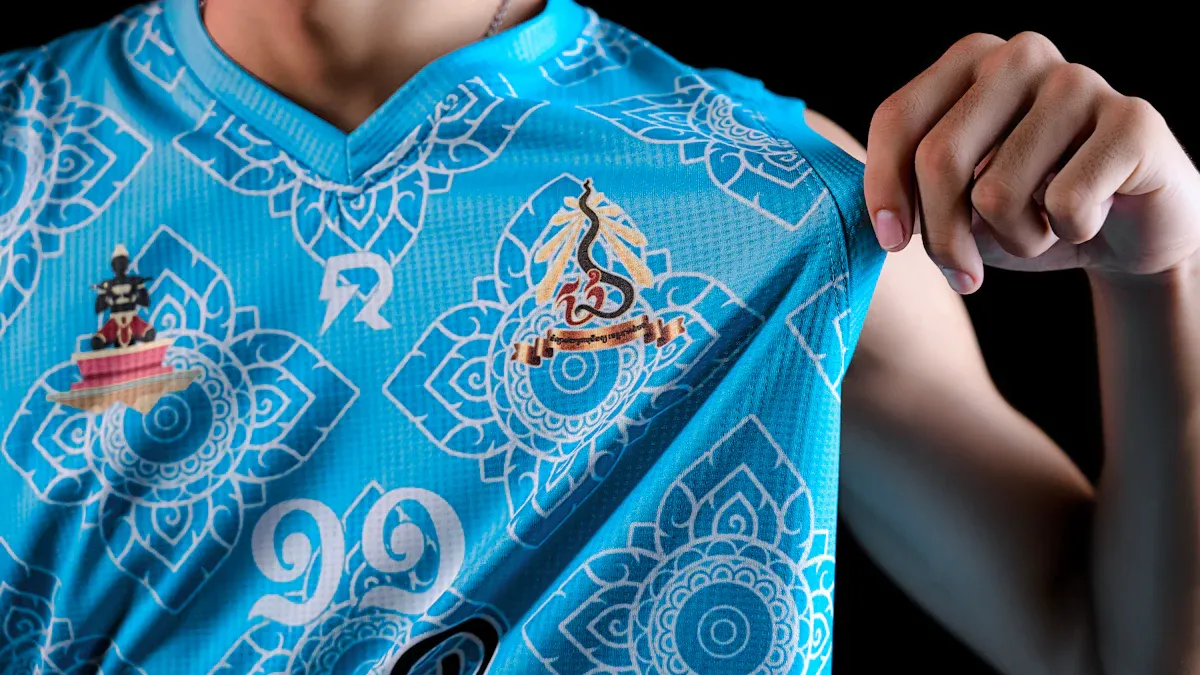
Leggings
You probably love wearing leggings for workouts, school, or just hanging out at home. Jersey fabric makes leggings feel soft and stretchy, so you can move easily. When you pick jersey for leggings, you get a fabric that hugs your body but never feels tight. The stretch in jersey fabric lets you bend, squat, and run without any trouble. If you like yoga, you’ll notice how jersey leggings move with you and never lose their shape.
Many people choose jersey fabric for leggings because it is lightweight, durable, and wrinkle-resistant. You can wear your leggings all day, and they still look fresh. Sewing your own leggings is a fun project. You can pick your favorite color or print and even add a side pocket to leggings for your phone or keys. If you want to try something new, sew a matching hoodie with leftover jersey fabric for a cozy set.
Tip: When sewing leggings, use a zigzag stitch or a serger. This helps the seams stretch with the fabric and keeps your leggings strong.
Jersey fabric is also great for making performance gear like gloves and knee supports. The fabric’s breathability keeps you cool, and the stretch gives you a snug fit. If you want to add a side pocket to leggings, just sew a small rectangle of jersey on the outer thigh. It’s simple and super useful!
Sportswear
Jersey fabric isn’t just for leggings. You can use it for all kinds of sportswear, like yoga pants, running tops, and even a hoodie for chilly mornings. The fabric’s moisture-wicking ability keeps sweat away, so you stay dry during workouts. Jersey blends with spandex or polyester give you extra stretch and help your clothes keep their shape.
Here’s a quick look at why jersey fabric works so well for activewear:
Property | Why It Matters for Sportswear |
|---|---|
Lets you move freely and keeps shape | |
Breathability | Keeps you cool and comfortable |
Moisture-wicking | Pulls sweat away from your skin |
Durability | Stands up to lots of washing and wearing |
Wrinkle-resistance | Always looks neat, even after workouts |
You can sew sports bras, shorts, and even protective gear with jersey fabric. If you want to try sewing, start with a simple pattern for a hoodie or a pair of leggings. Jersey makes it easy to create clothes that fit your style and your life.
Loungewear and Intimates
Pajamas
You want pajamas that feel soft, stretch with your body, and keep you cool at night. Jersey fabric checks all those boxes. When you slip into pajamas made from jersey, you notice the gentle touch right away. The fabric moves with you, so you never feel restricted. You can find pajamas in cotton jersey, which is lightweight and perfect for every season. Some brands, like Friendtex, use 100% cotton jersey for pajamas that stay soft and hold their shape, even after many washes.
Jersey pajamas are easy to care for. You can toss them in the washing machine, and they come out looking great. The fabric resists wrinkles, so you spend less time ironing and more time relaxing. If you have sensitive skin, jersey pajamas are a smart choice. The fabric is hypoallergenic and gentle. When you start sewing your own pajamas, you can pick from many colors and prints. Try a relaxed fit for extra comfort, or add pockets for a fun touch.
Tip: Choose medium or heavyweight jersey for winter pajamas. You’ll stay warm without feeling bulky.
Underwear
Comfort is key when you pick underwear. Jersey fabric gives you softness, stretch, and breathability. You can find jersey made from cotton, bamboo, rayon, or blends with spandex. Each type offers something special. Cotton jersey feels natural and absorbs moisture. Bamboo jersey is smooth and cool. If you want underwear that keeps its shape, look for jersey with spandex.
When sewing underwear, test the fabric’s stretch first. You want at least 50% stretch for a good fit. Use a stretch needle, like a Schmetz Stretch Sewing Machine Needle, to avoid skipped stitches. Try sewing with a zigzag stitch to keep seams flexible. You can make briefs, boxers, or bralettes that fit your style and comfort needs.
Here’s a quick table to help you choose the right jersey for your next underwear project:
Jersey Type | Best For | Key Benefit |
|---|---|---|
Cotton Jersey | Everyday wear | Soft, breathable |
Bamboo Jersey | Sensitive skin | Cool, hypoallergenic |
Rayon Jersey | Lightweight feel | Smooth, drapey |
Jersey with Spandex | Active underwear | Extra stretch, shape |
Note: Always test both the fabric and elastic before sewing. This helps you get the perfect fit every time.
Baby and Kids’ Clothing
Onesies
When you dress your baby, you want them to feel cozy and safe. Onesies made from jersey fabric are a top pick for parents. Jersey feels soft against your baby’s skin and stretches as your little one moves. This means your baby can wiggle, crawl, or nap without feeling tight or itchy. You can wash jersey onesies again and again, and they still look and feel great. That’s a big win for busy families!
Jersey also keeps your baby cool because it lets air flow. If you want to make a special gift, try sewing a matching onesie and baby blanket set. The fabric’s gentle touch helps prevent irritation, which is perfect for sensitive skin. Many parents love using jersey for baby blanket projects, too. You can even find double-knit jersey for extra warmth on chilly days.
Tip: Choose fun prints or soft pastels for your next jersey onesie or baby blanket. Babies love bright colors and playful patterns!
Playwear
Kids love to run, jump, and play. Jersey fabric keeps up with every move. It stretches in all the right places, so your child stays comfy during playtime. You don’t have to worry about rough seams or scratchy tags. Jersey’s smooth surface and breathability help prevent overheating, even on busy days at the park.
Here are some best practices for sewing jersey playwear:
Find the direction of greatest stretch and line up your pattern for the best fit.
Pre-wash your fabric to avoid shrinking after you sew.
Use a ballpoint needle and a zigzag stitch to keep seams strong and stretchy.
Try a double-needle for hems that look neat and last longer.
Leave some hems unfinished for a cute, curly edge—jersey won’t fray!
Jersey playwear stands up to lots of washing and rough play. You can even use leftover fabric to make a matching baby blanket or headband. Kids love the soft feel, and you’ll love how easy it is to care for.
Home Décor Projects
Looking to add a cozy touch to your space? Jersey knit fabric brings warmth and comfort to your home décor projects. You can use it for everything from a soft blanket to a stylish curtain. Jersey feels inviting, so your living room or bedroom becomes a place where everyone wants to relax.
Pillow Covers
You can make your own pillow covers with jersey knit fabric. The fabric feels soft and breathable, so your pillows stay comfy all year. Jersey is wrinkle resistant, so your pillow always looks neat. You can pick from many colors and prints to match your style. If you want a quick project, try a simple envelope-style cover. Jersey stretches, so it fits snugly over your pillow insert. You can even add a matching blanket for a complete look.
Jersey knit fabric is easy to sew, even if you are new to DIY projects.
The stretch makes it simple to slip covers on and off for washing.
Printed jersey adds a fun texture and color to your décor.
Tip: Mix and match different jersey prints for a playful look on your couch or bed.
Curtains
Jersey knit fabric works well for curtains, too. The fabric drapes beautifully, so your curtains hang in soft folds. Jersey is durable and stands up to daily use. You can wash your curtains often, and they still look fresh. The stretch in jersey makes it easy to handle, so you can sew curtains even if you are just starting with home projects.
Jersey curtains add a relaxed, inviting feel to any room.
You can choose bold prints or soft solids to fit your style.
The fabric’s flexibility lets you create custom lengths and shapes.
If you want to try more projects, use jersey for a lightweight blanket, a throw, or even a fabric garland. Jersey makes every project feel special and personal. You can create a matching set with a blanket, pillow, and curtains for a cozy, unified look.
Upcycling Jersey Fabric
Repurposed Garments
You don’t have to throw away old jersey clothes. You can turn them into something new and useful with a little creativity. Upcycling jersey fabric is a fun way to give your old favorites a second life. Here are some easy diy ideas you can try at home:
Dye your old jersey shirts to give them a fresh color. You can use fabric-safe dyes or even natural dyes like onion skins.
Patch or embroider over holes or stains. This adds a personal touch and makes your clothes unique.
Cut and reshape old t-shirts into shorts, skirts, or even a new tank top. You can use simple sewing techniques for these diy projects.
Transform jersey scraps into home items like quilts, tote bags, or pillow covers. These sewing projects are great for beginners.
Make scrunchies, pet beds, or reusable bags. Jersey’s stretch and softness make these projects easy and fun.
Cut worn-out jersey into squares for reusable cleaning cloths. This is a smart way to reduce waste.
Wrap gifts with jersey fabric for an eco-friendly touch. Just fold and knot the fabric around your present.
Tip: Upcycling jersey fabric helps the planet and lets you practice new sewing skills. You can finish many of these diy projects in just one afternoon!
Accessories
Jersey fabric is perfect for making accessories. You can use leftover scraps from other sewing projects or upcycle old clothes. Many diy crafters love turning jersey into stylish and practical items. Check out some popular accessories you can make:
Accessory Type | Description |
|---|---|
Trendy headbands with a knot in the center, great for everyday wear. | |
Bow Headbands | Cute headbands with bows, perfect for casual or retro looks. |
Twisted Turban Headbands | Headbands with a twist, ideal for keeping hair in place during activities. |
Scrunchies | Soft, stretchy hair ties that add color and style to your outfit. |
Tiny Scrap Tote Bags | Small bags made from jersey scraps, handy for carrying small items. |
Ear Warmers | Wide headbands that keep your ears warm without messing up your hair. |
Beanie Hats | Cozy hats that you can also turn into scarves or ear warmers. |
Baby Hats | Soft, warm hats for infants, made from leftover jersey fabric. |
You can finish most of these diy accessories with basic sewing skills. Try making a headband or scrunchie as your next project. These sewing projects are quick, fun, and make great gifts for friends or family.
Accessories
Headbands
You can turn a small piece of jersey into a stylish headband in just a few minutes. Jersey stretches and feels soft, so your headband stays comfortable all day. Many people love extra wide boho styles because they keep hair in place during yoga or workouts. Solid color ribbed headbands look simple but trendy. If you want something different, try a soft stretchy twist headband. These designs work for any hair type and fit almost any head size.
Here are some popular jersey headband styles you can try for your next diy project:
Extra wide boho headbands for a relaxed look
Solid color ribbed headbands for everyday wear
Soft and stretchy twist headbands for a fun twist
Self-tie headbands that you can adjust for the perfect fit
You can make a diy knit headband with leftover jersey from other projects. Just cut a strip, sew the ends, and add a twist or knot. Many people use these headbands for sports, school, or just hanging out. If you want to match your outfit, pick a jersey in your favorite color or pattern. Try making a set of headbands for friends or family. It’s a quick and easy diy gift!
Tip: Wash your jersey headband in cold water and let it air dry. This keeps it stretchy and soft.
Scarves
A jersey scarf feels cozy and looks great with any outfit. You can make a diy scarf in less than an hour. Many people love wide jersey head scarves with self-tie knots. These scarves come in lots of colors and patterns, like florals, glitter dots, or classic black. They feel light but keep you warm on cool days.
If you want to learn how to make an infinity scarf, jersey is the best fabric to use. It stretches, drapes well, and never feels bulky. Here’s a simple way to start:
Cut a long strip of jersey.
Sew the short ends together.
Twist once and sew again for a loop.
Now you know how to make an infinity scarf! Try making a few in different prints. You can wear a jersey scarf as a headband, neck wrap, or even a belt. Many people use diy scarves as gifts or to add color to their wardrobe. If you want to try something new, look up how to make an infinity scarf with a twist or fringe. Jersey makes every diy project fun and easy.
Note: Machine wash your jersey scarf for easy care. It will stay soft and bright, even after many wears.
Functional Details
Pockets
You probably love having pockets in your clothes. They make life easier by giving you a place to keep your phone, keys, or even a snack. Jersey knit fabric works well for adding pockets to all kinds of garments, from hoodies to leggings. The stretch in jersey means your pockets move with you, so you never feel restricted.
When you want to add pockets, start by marking where you want them on your garment. Use pins or fabric markers for this step. Next, work to the first marker and bind off stitches up to the second marker. This creates the pocket opening. Pick up the pocket lining stitches and knit them onto your garment. Pull the lining through the opening so it sits inside. After you finish sewing the garment, use a tapestry needle to seam the sides and bottom of the pocket lining. Try to keep your stitches neat so they don’t show on the outside.
Tip: If you’re sewing leggings, consider adding a hidden pocket at the waistband. It’s perfect for holding small items during a workout.
Jersey knit fabric also lets you get creative. Some designers use conductive yarns in pockets for smart features, like charging your phone or tracking steps. This turns a simple pocket into a high-tech helper.
Linings
Linings make your clothes feel smoother and last longer. Jersey knit fabric is lightweight, so it adds comfort without making your clothes bulky. You can use jersey as a lining in dresses, jackets, or even leggings. The fabric’s breathability keeps you cool, while its softness feels great against your skin.
When sewing a lining, knit the pocket lining first or use waste yarn to create openings. Always check your gauge to make sure the lining fits well. Attach the lining by sewing it to the garment’s inside edges. This keeps seams hidden and gives your project a clean finish. Jersey linings also help manage moisture and temperature, which is great for activewear.
Note: Flat knitting technology lets you adjust patterns and structures, so you can create linings that fit perfectly and add extra comfort.
If you want to try sewing linings, start with a simple project like a lined skirt or a pair of leggings. You’ll see how much difference a soft, stretchy lining can make.
Medical and Tech Uses
High quality jersey knit fabric is not just for clothes. It is also used in medical and tech products. The fabric stretches, lets air through, and feels soft. This makes it good for things that touch your skin and need to move with you.
Bandages
Many bandages and dressings are made with jersey knit fabric. The fabric feels soft and gentle on your skin. This is important when you have a cut or need extra care. Jersey knit can stretch and move as you move. Your bandage stays in place, even if you are active. This helps the bandage fit around places like elbows or knees.
Jersey knit bandages let your skin breathe. This helps wounds heal because air can get in. Some bandages use special yarns to pull away sweat or fight germs. This keeps your skin dry and clean. You can wear these bandages for a long time. They do not make you feel itchy or uncomfortable.
Here is a table that shows how jersey knit fabric is used in medical products:
Application Category | Examples of Uses | Key Properties |
|---|---|---|
Non-Implantable Medical Textiles | Bandages, dressings, surgical clothing | Stretchy, breathable, gentle |
Healthcare and Hygiene Products | Mattress covers, protective goods | Elastic, durable, soft |
Tip: If you want a bandage that stays put, pick one made with jersey knit fabric.
Compression Wear
Jersey knit fabric is also used for compression wear. You might see compression socks, sleeves, or wraps in stores. These items help blood flow and support your muscles. Jersey knit fabric stretches and bounces back. This makes it great for compression wear. The fabric hugs your body and gives steady pressure. This helps you heal and feel comfortable.
Compression wear made from jersey knit fits close but is not too tight. The fabric lets your skin breathe, even if you wear it all day. Some compression clothes use special yarns for more support or to keep you dry. You can find compression wear for your legs, arms, or body.
Jersey knit compression wear helps with:
Swelling and blood flow problems
Recovering after sports
Comfort for people who stand or sit a lot
Note: If you need help after an injury or surgery, ask your doctor about jersey knit compression wear. It is made to help you heal and feel good.
Jersey knit fabric is a smart pick for medical and tech uses. It gives you comfort, stretch, and support in one fabric.
You can do so much with high quality jersey knit fabric. It feels soft, stretches with your body, and keeps you cool and comfortable. Most people rate cotton jersey as the softest for daily wear, and ribbed jersey adds a fun texture to both clothes and home décor. Try these ideas to get creative:
Mix colors and prints by laying fabrics side by side or sketching your project.
Upcycle old shirts or fabric scraps into new accessories or home items.
Experiment with layering sheer knits or using digital mockups for bold designs.
Jersey knit fabric makes every project fun and rewarding. Give it a try—you might surprise yourself!
FAQ
What is the best way to cut jersey knit fabric?
You should use sharp fabric scissors or a rotary cutter. Lay the fabric flat and smooth out any wrinkles. This helps you get clean, even edges. If you want, use pattern weights instead of pins to avoid stretching the fabric.
How do I stop jersey knit fabric from curling at the edges?
Try pressing the edges with a warm iron. You can also use a spray starch. If you sew a zigzag or overlock stitch along the edge, it helps keep the fabric flat.
Can I sew jersey knit fabric with a regular sewing machine?
Yes, you can! Use a ballpoint or stretch needle. Set your machine to a zigzag or stretch stitch. This lets the seams move with the fabric. Test on a scrap first to check your settings.
What projects are easiest for beginners using jersey knit fabric?
T-shirts
Simple skirts
Pillow covers
Headbands
These projects use basic shapes and straight seams. You can finish them quickly and build your confidence with jersey fabric.
How should I wash and care for jersey knit items?
Wash your jersey items in cold water. Use a gentle cycle. Lay them flat to dry or tumble dry on low. This keeps the fabric soft and stretchy. Avoid using bleach or high heat.



